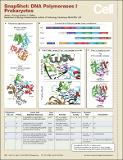SnapShot: DNA Polymerases I Prokaryotes
Author(s)
Foti, James J.; Walker, Graham C.
DownloadWalker_Snapshot.pdf (1.181Mb)
PUBLISHER_POLICY
Publisher Policy
Article is made available in accordance with the publisher's policy and may be subject to US copyright law. Please refer to the publisher's site for terms of use.
Terms of use
Metadata
Show full item recordAbstract
The nucleus and mitochondria of eukaryote cells and the nucleoid of prokaryote cells contain remarkable enzymes, called DNA polymerases, which ensure the faithful duplication of genetic material. These enzymatic machines incorporate the building blocks of DNA, deoxyribonucleotide triphosphates (dNTPs), into growing polynucleotide chains. The error rate of these enzymes is astonishingly low with only ~1 error for every 10 [superscript 9]–10[superscript 10] bases replicated. The first safeguard contributing to this low error rate is the ability of the DNA polymerase to discriminate among incoming dNTPs based on their complementarity to a parental DNA template. However, in the event of misincorporation, many DNA polymerases also have associated “proof-reading” activities that remove an inappropriately added dNTP, thus providing a second safeguard to protect the integrity of the genome. Moreover, cells use a variety of DNA polymerases, called translesion DNA polymerases, whose sole function is to enable recovery from specific genetic insults by endogenous and exogenous mutagens.
Date issued
2010-04Department
Massachusetts Institute of Technology. Department of BiologyJournal
Cell
Publisher
Elsevier B.V.
Citation
Foti, James J., and Graham C. Walker. “SnapShot: DNA Polymerases I Prokaryotes.” Cell 141, no. 1 (April 2010): 192–192.e1.
Version: Final published version
ISSN
00928674